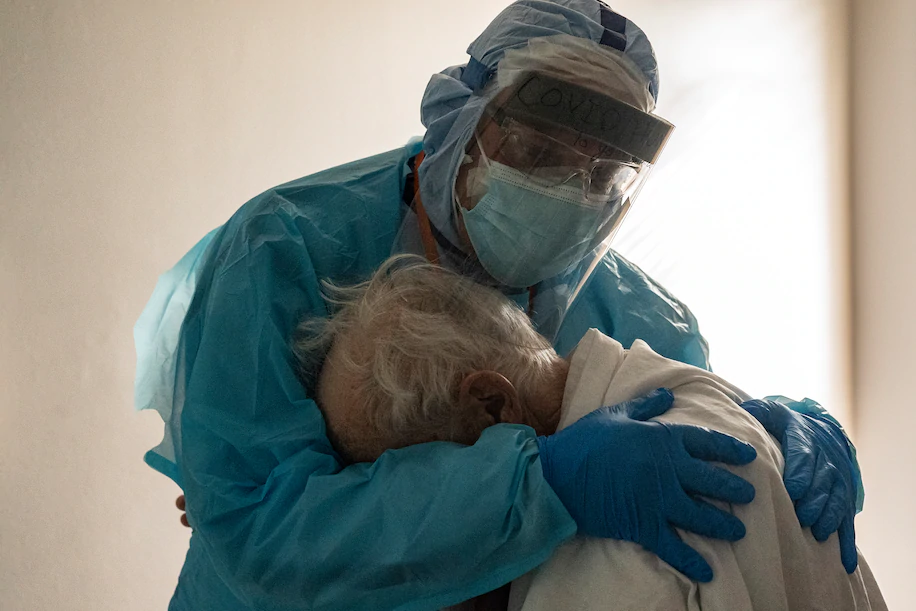COVID-19: US Medical System In Emergency
COVID-19: US Medical System In Emergency
COVID-19: US Medical System In Emergency. U.S. medical system is in emergency, nearly 100,000 patients with COVID-19 pneumonia hospitalized according to news on Dec 03 2020

This is a heartbreaking photo of Dr. Joseph Wallen of the United Memorial Medical Center in Houston comforting a patient with COVID-19 pneumonia. The photo was taken on Thanksgiving Day, which was a traditional American holiday for family reunion. The white-haired old man cried alone in the intensive care unit: “I want to be with my wife.”
According to a report from the Washington Post on November 30, local time, Dr. Warren has worked continuously for more than 256 days. “I often walk into the patient’s room and sit on the hospital bed to chat with them because they need to be with them.” Dr. Wallen said, these patients often cry because they can’t stand loneliness and despair. Some even tried to break the window to escape from the hospital.
Dr. Warren is very pessimistic about the current situation in the United States: “If people continue to refuse to do the right thing, the United States will face the darkest days in modern history.”
The number of hospitalizations doubled within 30 days
On November 18, local time, a reporter from the “Washington Post” visited a Mayo Medical Center hospital in Wisconsin. The Mayo Medical Center is one of the largest comprehensive medical institutions in the United States.
The hospital has a total of 160 beds. At 9 am, the number of inpatients reached 166, exceeding the hospital’s capacity limit. At 12 noon, the overloaded hospital had to send patients to other clinics. In the late afternoon, the hospital set up four temporary beds in the ambulance garage, ready to accept new patients.
The New York Times reported on November 27 that the U.S. medical system is in emergency. From New Mexico to Minnesota to Florida, every hospital is troubled by the surge in the number of patients with COVID-19 pneumonia, the shortage of beds, and the shortage of medical staff. Some states provide temporary licenses for medical school students, requiring them to work urgently.
According to data from the US COVID-19 Epidemic Tracking Project, as of December 1, local time, the number of hospitalized patients with COVID-19 pneumonia in the United States reached 98,691, a record high. In the past month, this number has more than doubled.
Isolated patient dies alone
To control the spread of the epidemic, Mayo Medical Center prohibits family members from visiting hospitalized patients with COVID-19 pneumonia. Marcia Granley was downstairs in the hospital every day, waving away from the mother in the ward, and the mother and daughter comforted each other in this way. In order to let Granley know where his mother was, a large colored paper was posted on the window of the ward with the words “Mom’s Room” on it.
Because they are isolated in the ward, severely ill patients with COVID-19 pneumonia often die without their relatives.
A few days ago, nurse Marybeth Pickler spent the last time of her life with the same patient. “We sat on the floor together,” Pickler said. “He talked about his past, how he farmed and owned cows, and how he sold the cows and owned Angus cows.” 25 minutes later, the patient took off the oxygen. Mask, pass away.
According to the Washington Post, due to the continuous surge in deaths, in El Paso, Texas, the remains of many patients with COVID-19 pneumonia were placed in 10 refrigerated trailers outside the doctor’s office.
Family gatherings have become an important way for the spread of the epidemic
63-year-old Mark Allens and his wife were hospitalized with the COVID-19 virus. Although they both live in the same ward at the Mayo Medical Center, they cannot meet. His wife had just received surgery to remove severe lung fluid, and she was also an amputee with diabetes and high blood pressure. Before being admitted to the hospital, the couple had lived with their grandson for a week, and they were most likely infected with the virus from the child.
At present, family gatherings are considered an important way for the spread of the COVID-19 virus, but gatherings are still going on. An Associated Press report on November 26 pointed out that in the week before Thanksgiving, an average of 1 million Americans flew home to reunite every day. This was the busiest week for airlines since the outbreak of the COVID-19.
“We will see more people being infected during Thanksgiving,” said Harvard University epidemiologist Michael Mina. “In the three or four weeks after Thanksgiving, more people will die.”
In response, medical staff issued an appeal in the Wisconsin Daily, asking the public to help prevent the further spread of the epidemic. “If you don’t make changes right away, the hospital will no longer be able to accept patients. You or your loved ones may need us, but we will not be able to provide medical assistance whether it’s patients with COVID-19 pneumonia, cancer, heart disease or other emergencies. As medical care People, we are terrified of this reality.”
Statistics from Johns Hopkins University in the United States show that as of the evening of December 2 local time, the number of COVID-19 pneumonia infections in the United States has reached 13,921,374, with 273,799 deaths, 18,083 new cases in a single day, and new deaths in a single day The number of cases hit a record high, reaching 2,658. In November alone, there were 4 million new infections in the United States, surpassing the total number of infections in any country in the world except India and Brazil.
(source:cctv)



